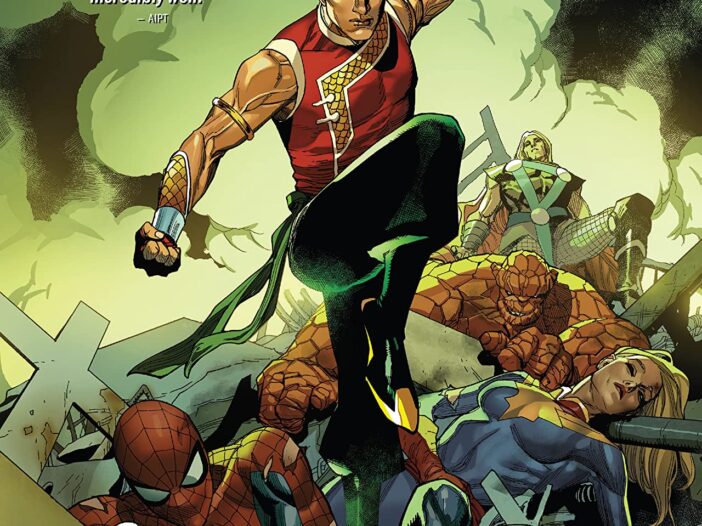
Shang-Chi By Gene Luen Yang Vol. 2 | Review
 Shang-Chi By Gene Luen Yang Vol. 2: Shang-Chi Vs.The Marvel Universe
Shang-Chi By Gene Luen Yang Vol. 2: Shang-Chi Vs.The Marvel Universe
Writer: Gene Luen Yang
Artist: Dike Ruan
Marvel Entertainment; $17.99
Rated T+ for teens 13 and above
For the second collection of Gene Luen Yang and Dike Ruan’s new Shang-Chi ongoing series, officially entitled Shang-Chi By Gene Luen Yang Vol. 2: Shang-Chi Vs. The Marvel Universe, the creators have a clever if perhaps uninspired strategy for ensuring interest in the book from the wider Marvel fandom: Guest-stars, and lots of them.
Each of the six issues sees the title character and his siblings/underlings in The Five Weapons Society, the evil organization of his late, evil father’s that he has assumed control of and is trying to reform into a force for good (and the comic book equivalent of the movie’s Ten Rings), crossing paths with a different hero or group of heroes. More often than not, this involves a fight, or at least the appearance of a fight, but for varying reasons: Sometimes there’s a misunderstanding, sometimes a hero temporarily turns into a monster, sometimes Shang-Chi needs to keep up a villainous front in the eyes of other bad guys—you know, comic book stuff.
ADVERTISEMENT
ADVERTISEMENT
And so Shang-Chi and his sister team-up with Spider-Man to take down a New York City drug ring; he pretends to fight Captain America at an underworld auction; he comes to blows with Wolverine over recruiting his half-sister, a mutant, to either join the Society or the X-Men; he breaks into the Fantastic Four’s headquarters to “borrow” an interdimensional ship of theirs; he fights Iron Man over a misunderstanding regarding a weapons deal, and finally, when the various heroes all form a sort of intervention to determine if Shang-Chi’s reformed evil organization is maybe still a little too evil, our hero must face off against Thor.
In addition to filling the book with other heroes and thus potentially piquing the interest of more Marvel fans, the strategy allows Yang and Ruan to pretty quickly and efficiently establish Shang-Chi, his family and his organization as central to the goings-on of the Marvel Universe. It’s not a sustainable long-term strategy, of course—for one thing, they’ve already cycled through a good chunk of the Marvel Universe—but it works fine for the length of a story arc.
Visually, the book remains a bit disappointing, although this volume—which Ruan draws the entirety of himself—proves stronger than the previous one. While the art is well within the expected range of quality from a mainstream super-comics publisher like Marvel, it is less impressive than that which usually accompanies a Yang-written book, and it continues to make no real room to showcase what is Shang-Chi’s defining characteristic as a superhero, and that which differentiates him from all the other heroes he crosses paths with in this book—that is, his martial arts ability.
It’s a challenging thing to depict in the comics medium, of course, especially when it’s not the focus of the story as in some fight manga, and Yang and Ruan seem to have met the challenge mostly by ignoring it, with little more than a handful of panels per issue devoted to any demonstration of martial arts per issue, often to the detriment of the book as an action-adventure narrative.
Filed under: Reviews
About J. Caleb Mozzocco
J. Caleb Mozzocco is a way-too-busy freelance writer who has written about comics for online and print venues for a rather long time now. He currently contributes to Comic Book Resources' Robot 6 blog and ComicsAlliance, and maintains his own daily-ish blog at EveryDayIsLikeWednesday.blogspot.com. He lives in northeast Ohio, where he works as a circulation clerk at a public library by day.
ADVERTISEMENT
ADVERTISEMENT
SLJ Blog Network
Name That LEGO Book Cover! (#53)
Cover Reveal and Q&A: The One and Only Googoosh with Azadeh Westergaard
Fighting Public School Book Bans with the Civil Rights Act
Take Five: Middle Grade Anthologies and Short Story Collections
ADVERTISEMENT







